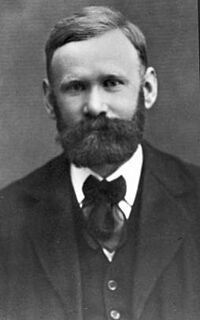Agner Krarup Erlang facts for kids
Quick facts for kids
Agner Krarup Erlang
|
|
|---|---|
 |
|
| Born | 1 January 1878 Lønborg, Denmark
|
| Died | 3 February 1929 (aged 51) Copenhagen, Denmark
|
| Resting place | Sundby Kirkegård, København, Denmark |
| Alma mater | University of Copenhagen |
| Occupation | Mathematician, statistician, and engineer |
Agner Krarup Erlang (born January 1, 1878 – died February 3, 1929) was a very smart Danish mathematician, statistician, and engineer. He is known for inventing the fields of traffic engineering and queueing theory. These ideas help us understand how things like phone calls or people waiting in line work efficiently.
Erlang spent his career studying telephone networks. He figured out how to make phone systems work smoothly. His ideas led to the famous Erlang formula. This formula is still a key part of how modern telecommunication networks are designed and studied today. He passed away at 51, but his work changed how we think about communication.
Contents
Erlang's Early Life and Education
Agner Krarup Erlang was born in Lønborg, a small town in Jutland, Denmark. His father was a school teacher. Erlang was very bright from a young age.
- At 14, he passed a special exam for the University of Copenhagen with high marks. He was allowed to take it even though he was younger than usual.
- For the next two years, he helped his father teach at school.
In 1896, Erlang passed the university entrance exam with excellent results. He won a scholarship to the University of Copenhagen. There, he studied mathematics as his main subject. He also learned about astronomy, physics, and chemistry. He earned his master's degree in 1901. After graduating, he taught at different schools for seven years. He always kept his strong interest in mathematics.
Working with Telephones
Erlang was part of the Danish Mathematicians' Association. Through this group, he met Johan Jensen. Jensen was the Chief Engineer at the Copenhagen Telephone Company (KTAS). This company was connected to the International Bell Telephone Company.
In 1908, Erlang started working for the Copenhagen Telephone Company. He worked there for almost 20 years until he passed away in Copenhagen. He was also connected to the British Institution of Electrical Engineers.
Erlang's Big Ideas
While working at the telephone company, Erlang faced a big challenge. He needed to figure out how many phone lines were needed for good service. He also wanted to know how many telephone operators were needed to handle all the calls. Back then, most phone calls were connected by human operators using cord boards.
Erlang was a very hands-on researcher. He would go out and measure things himself. Sometimes, he even climbed into street manholes to collect data! He was also an expert in calculating mathematical tables, especially for logarithms. He even invented new ways to do these calculations.
How His Theories Developed
Erlang spent several years developing his ideas about telephone traffic. Here are some of his most important papers:
- 1909: "The Theory of Probabilities and Telephone Conversations." In this paper, he showed that the Poisson distribution could be used to understand random phone calls.
- 1917: "Solution of some Problems in the Theory of Probabilities of Significance in Automatic Telephone Exchanges." This paper included his famous formulas for lost calls and waiting times.
- 1920: "Telephone waiting times." This was his main work on how long people had to wait for a call.
His important papers were translated into English, French, and German. His writing style was very short and direct. It could be hard to understand without knowing a lot about the subject. It's even said that one researcher from Bell Telephone Laboratories learned Danish just to read Erlang's original papers!
The British Post Office started using Erlang's formulas. They used them to figure out how many phone circuits they needed.
The "Erlang" Unit
In 1946, a group called the CCITT decided to name the international unit for telephone traffic the "erlang". This was a great honor for him. A type of statistical distribution and even a computer programming language have also been named after him.
Erlang also helped create the Krogh-Erlang capillary cylinder model. This model helps explain how oxygen gets to living tissues in the body.
See also
 In Spanish: Agner Krarup Erlang para niños
In Spanish: Agner Krarup Erlang para niños
- Erlang – a unit of communication activity
- Erlang distribution – a statistical probability distribution
- Erlang programming language – developed by Ericsson for large industrial real-time systems
- Queueing theory
- Teletraffic engineering

